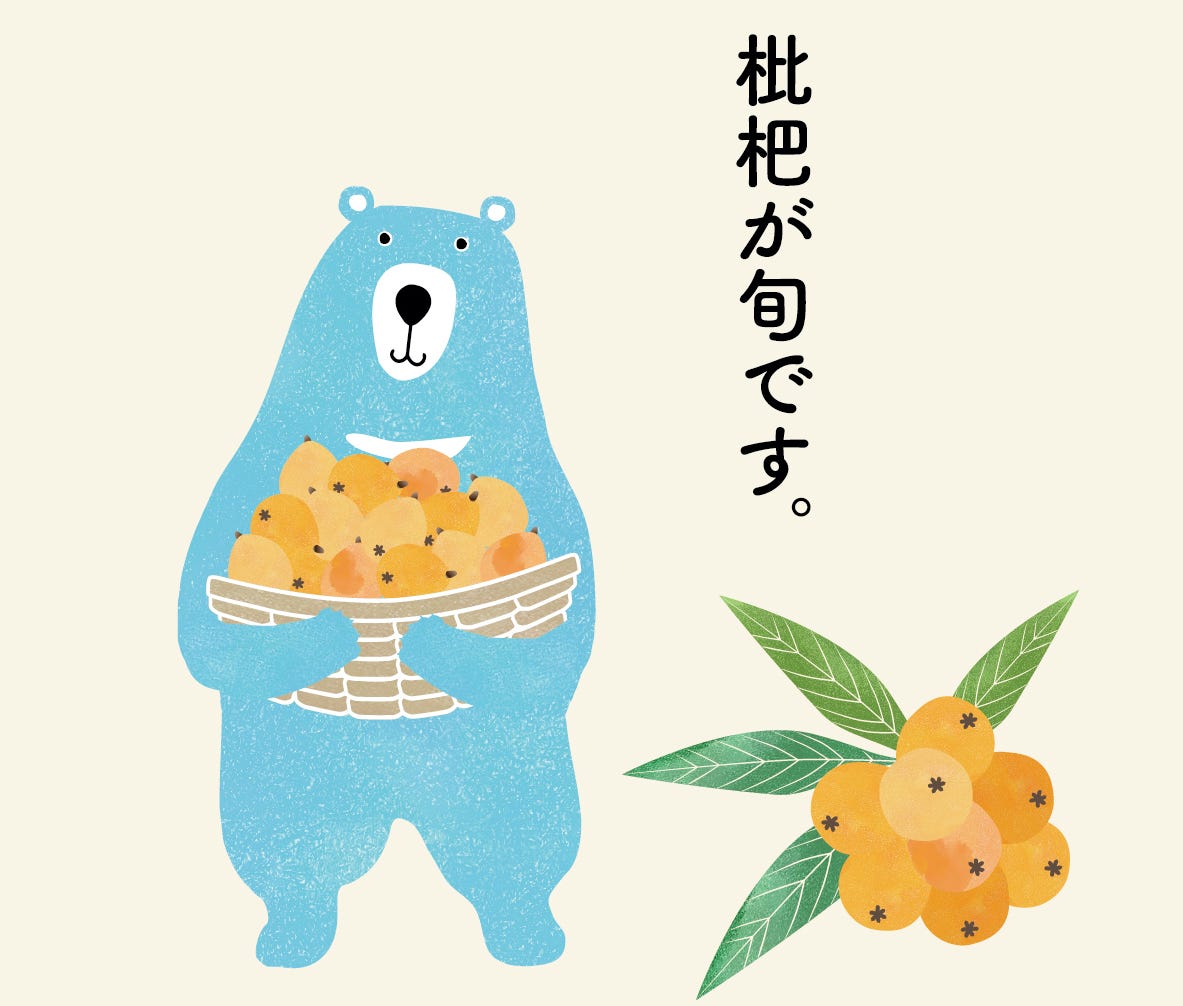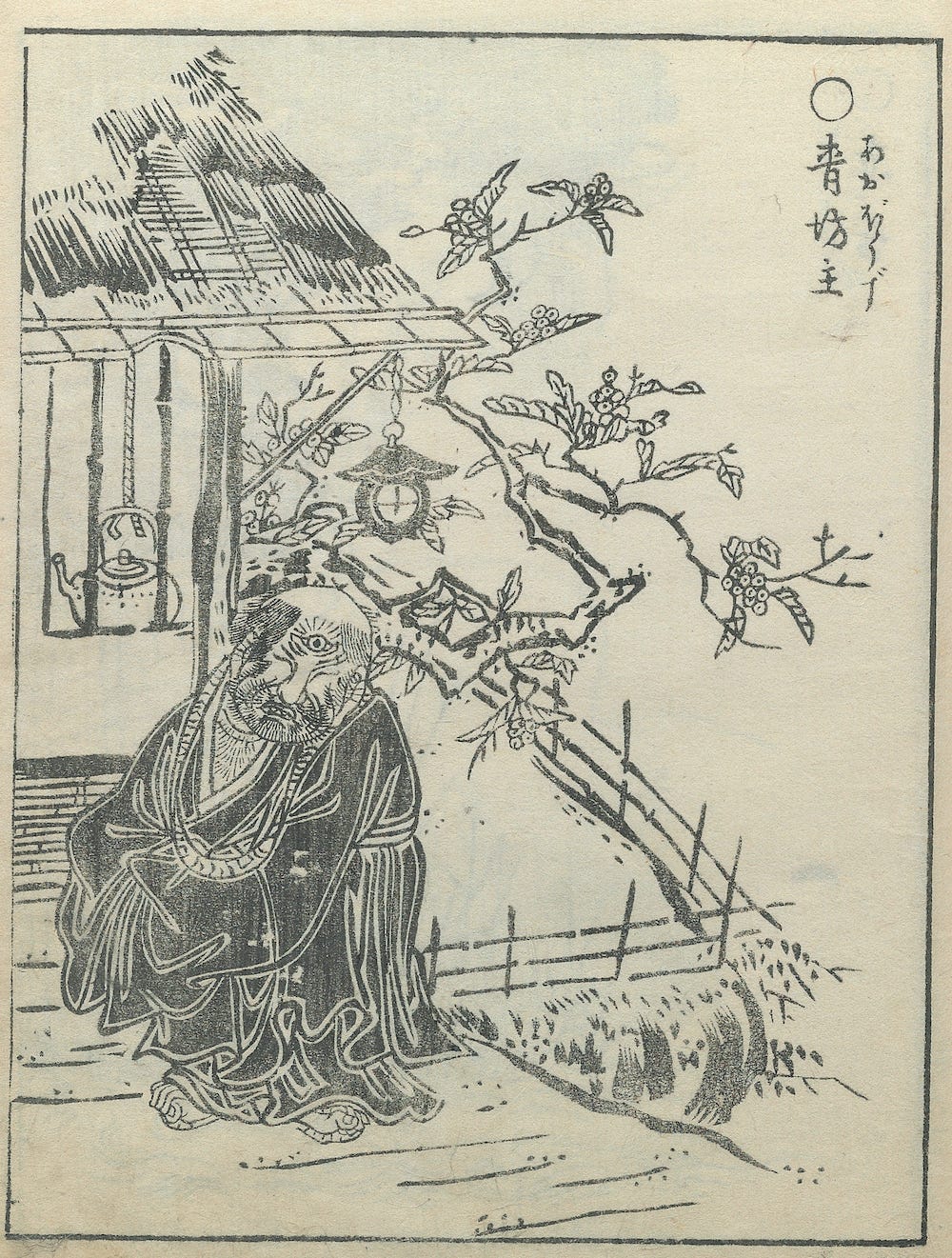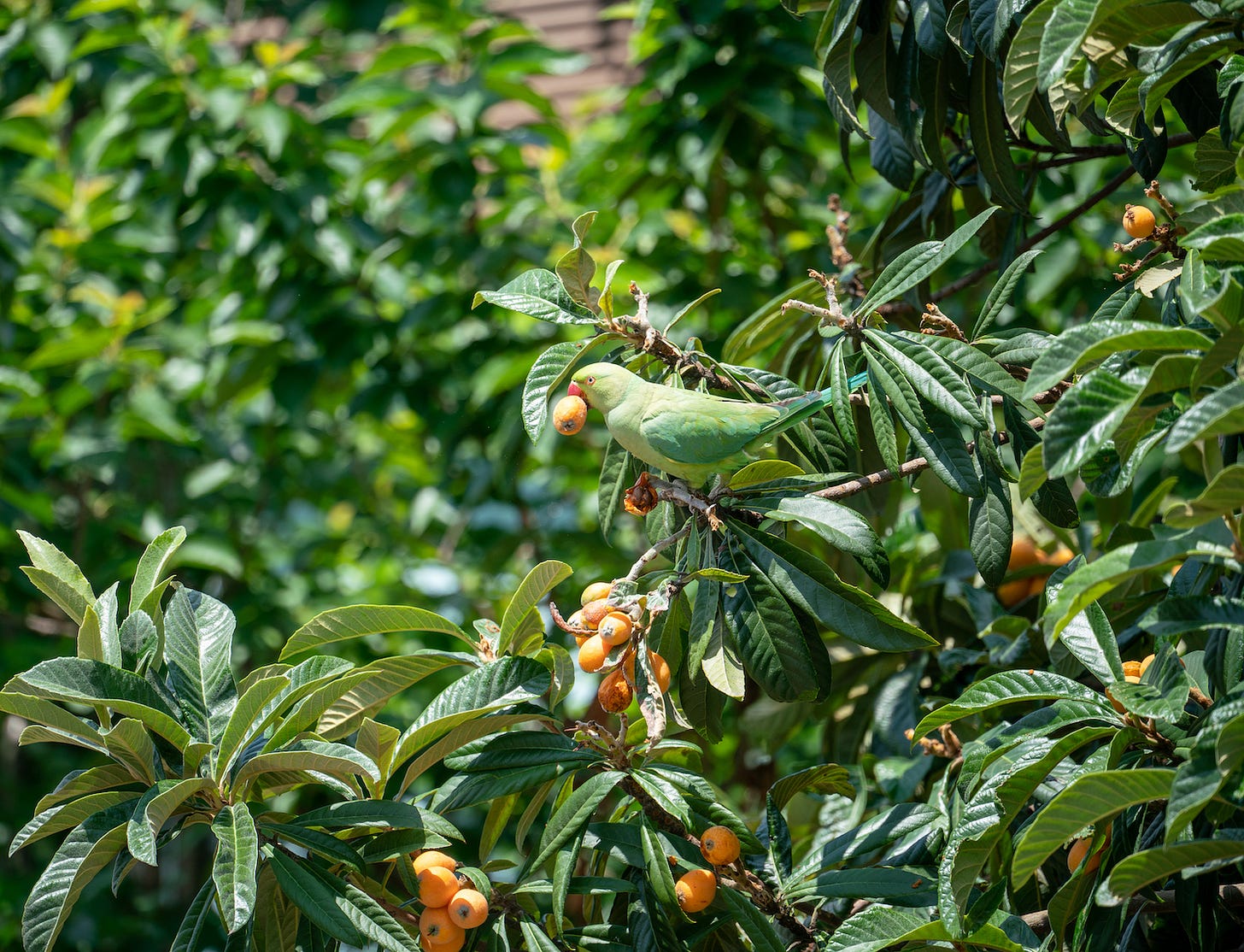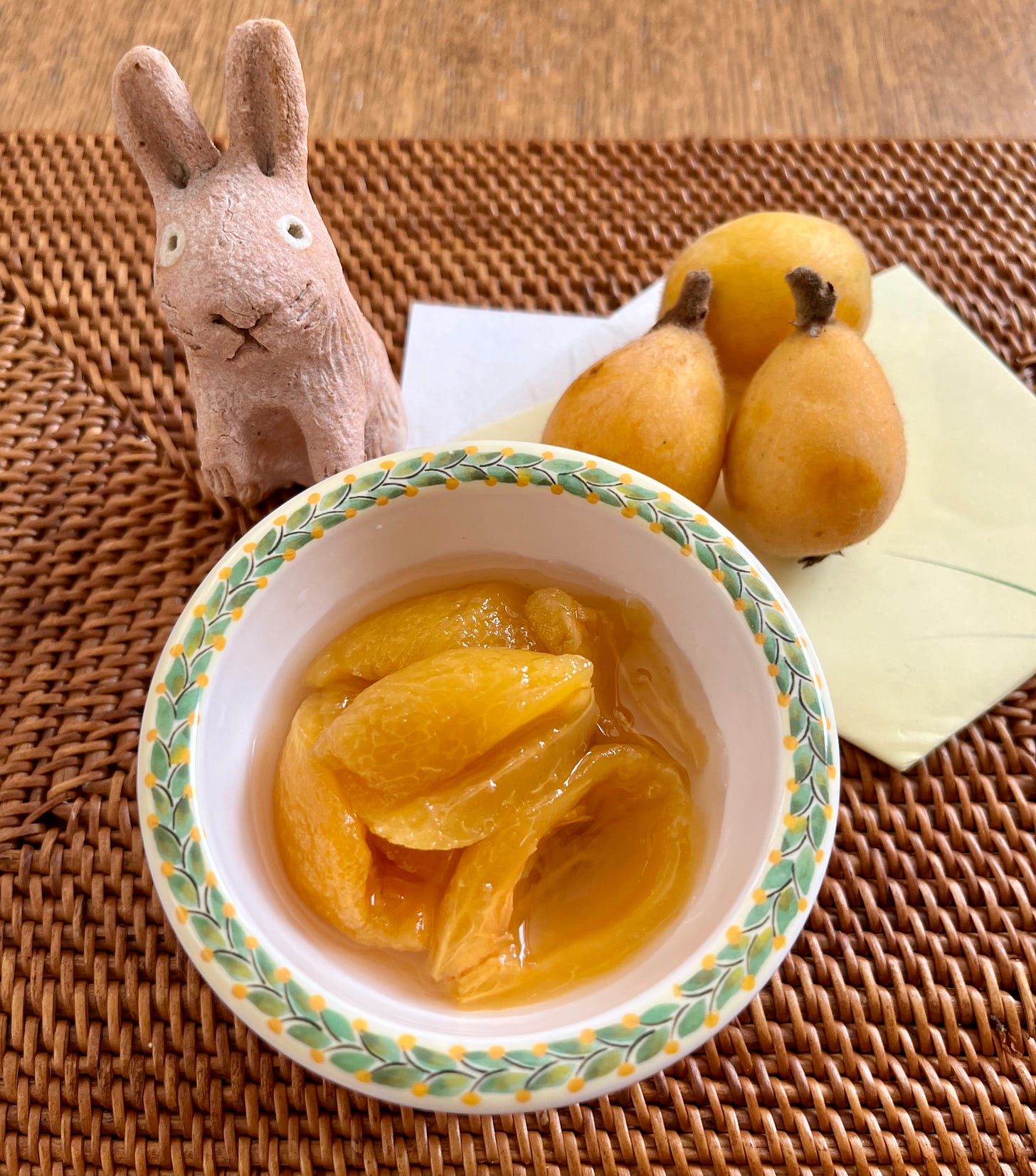Loquats Ripen in Abundance
I created my own personal little mini-season. You can too!
As I mentioned a few newsletters back, Japan uses the modern Gregorian calendar but also retains a much older one called shichijuniko, the Seventy-Two Microseasons, which celebrates seasonal changes throughout the year. In that spirit I’d like to declare my own personal little mini-season: Loquats Ripen in Abundance.
Loquat trees are native to China, but imported to Japan long ago by monks along with Buddhist teachings. The fruits range from the size of a large grape to a plum, with bright orange skins that are peeled to reveal the tender loquat inside. The flavor is sweet and subtle, reminiscent perhaps of apricot, but really its own thing. In Japanese, the trees and fruit are called biwa.
There is a vacant house in my neighborhood, once home to a kind elderly gentleman whom I remember used to take a little rest on the steps of our house when he’d go out on his daily walks. He seems to have had a green thumb, because he cultivated flowers and ornamental trees in his yard. One of them was a loquat tree. Perhaps to make it easier to pick the fruits, he situated the tree right next to his front gate. But ten years or so back, the old man passed away. The loquat lost its caretaker and began growing wild. In the decade since, its branches have thrust out in all directions, taking over his front yard and overhanging the walls and even obscuring the second story of the house. From a distance the tree now resembles a gigantic broccoli.
There is an old wives’ tale in Japan that planting a loquat tree on your property invites misfortune. There are variations on it, such as “loquat trees are fertilized by the sound of pain” and “when you plant a loquat, you invite sickness and death.” Heavy stuff! But it’s a fact that loquat trees were long considered “bad luck.”
This really confused me when I heard about it the first time. Loquat trees are everywhere in Japan, even more so when I was little and the suburb I lived in was less developed. My parents didn’t have a loquat tree, but many of our neighbors did. As a little girl I’d often poach fruits from one or another house, eating them right on the spot! I don’t recall ever getting scolded. Perhaps it’s because I was small. But more likely the owners didn’t care, because loquat trees bear huge amounts of fruit in season, making it easy to share with anyone.
Watching the neighbor’s tree go wild after losing its owner, I started to understand why this innocuous tree might be considered inauspicious. My husband and I have been amazed by the tree’s vitality, the speed at which it grows and the abundance of the fruits it produces, their weight causing the longer branches to dangle low over the street. In other words, the tree is getting a little out of control. It’s escaping the confines of the yard, and it has plunged the entryway of the vacant house into a humid darkness tinged by the scent of fallen, overripe fruit. A loquat needs constant trimming lest it take over your property altogether.
A few years back, my husband and I were localizing a 250 year old book series called Gazu Hyakki Yagyō, which is often rendered as “The Illustrated Night Parade of a Hundred Demons.” We eventually called our translated and annotated edition Japandemonium Illustrated: The Yokai Encyclopedias of Toriyama Sekien. (It came out in 2016, but it’s sadly out of print at the moment.) It is a guidebook to some two hundred ghosts, spirits, spooks and monsters that Sekien collected from literature, folklore, and art.
I bring this up because one of his entries contains a tree that looked very similar to the one near our house. The drawing was titled Ao-bōzu, “The Blue Monk,” and showed a strange creature standing in front of a teahouse with a loquat tree.
The thing about Sekien’s art, and I know this from long years spent deciphering it, is that everything he puts on the page means something. Not only the linework itself, but the details in each picture, even the layout of the page, even the arrangement of pages side by side – nothing is ever chosen randomly. I think of it as the “Sekien code,” for like all master artists, he carefully selected scenes and details according to some internal logic, hinting at themes related to the main subject. This particular drawing sent me down the rabbit hole of history and folklore about loquat trees. And this is what I found.
Loquat trees arrived from China along with Buddhism some 1,500 years ago. Monks brought them over for their healing properties, as the sutras describe the loquat tree as the 大薬王樹 (daiyaku-ōju), “The King of Medicinal Trees.”
Healers made use of the leaves for medicines, brewing tea from them, or even applying the leaves directly to the body as needed.
Today, we now know the leaves really do contain medicinal components, said to be efficacious for skin diseases, cuts and scratches, and capable of reducing high-blood pressure.
I also found several theories about those old wives’ tales. One was that, given the trees were known to cure all kinds of health issues, even way back when, planting one would logically mean attracting all sorts of sick people to your home. Another was more conspiratorial: perhaps the monks, who believed in the almighty power of the loquat, encouraged the negative rumors about the trees to keep average folk away from their business.
This is interesting stuff! Thanks to modern medicine, I’ve never seen or heard of sick people swarming loquat trees in my life. But this doesn’t mean the trees don’t attract visitors. They attract a great many of the non-human variety. Those juicy fruits are like candy to all sorts of animals. Crows, parakeets, and magpies see loquat trees as a free buffet, dropping in for a taste whenever they see a chance. As they knock fruit to the ground, other visitors drop by. My other neighbors who live next door to the vacant house told me they saw a pair of tanuki saunter out, undoubtedly satiated by the smorgasbord of fallen fruits free for the taking.
I love loquats, so I don’t mind others coming in for a share, should they pick them neatly. But animals, of course, don’t! They go “woo-hoo!” (in their various voices) and make a mess of things. The birds peck a bite and move to the next fruit, and the damaged ones start to rot. Eventually they drop to the ground, making a huge splattery mess that ferments in the early-summer heat, which in turn attracts less cute visitors, like flies and hornets.
So, my husband and I started picking. We began a few years back, and it’s turned into a little annual tradition. It helps keep the street clean, and we get a reward for our efforts in the form of a huge harvest of loquats. And boy, did we get a big haul this year. None of our neighbors seem to care about the fruits. We always offer them some, and they always politely refuse. So the bounty is ours for the taking.
At the moment my refrigerator’s vegetable drawer is filled with loquats. It’s a pretty ridiculous sight that makes me laugh every time I open the drawer. But I love it, because it’s so rare for a city girl like me to have such access to a virtually unlimited amount of fresh fruits. And even though they’re smaller than the ones they sell in the supermarkets, they’re just as tasty.
This year, we harvested so many loquats that I started making syrups and canning them. This is a loquat compote. It pairs well with a scoop of ice cream – the perfect dessert for my personal micro-season! Perhaps this is how new traditions are made? The Shichijuniko are optimized for Japan, but there’s no reason that you can’t make your own from your local environment!






I often take some loquats off the hands of neighbors who can't seem to get rid of them quickly enough! I once stayed at a pension in Izu where, when I opened my upstairs room window, there were ripe loquats free for the snacking.
As for microseasons- I do have my own backyard microseasons as a gardener all year long. I'm inspired to start writing them down!
I recently received some loquats from my host's brother who lives in our neighborhood in Itoshima (Kyushu). Such a warm gift. Is there a better way to feel at home in a place than eating the local, seasonal food that you can see ripen on the trees and on the fields?